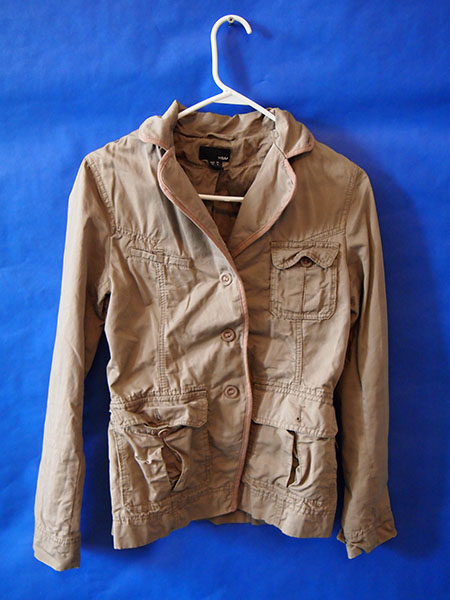![]() body | color | collections | commodity | cube | document | fabric | fetish | gender | glass | home | identity | living | machine | metal | minimal | mobility | narrative | olfactory | organic |
body | color | collections | commodity | cube | document | fabric | fetish | gender | glass | home | identity | living | machine | metal | minimal | mobility | narrative | olfactory | organic |
![]() pain | paper | plastic | plugs | power | protective | rectangular | ritual | round | sound | souvenir | spiritual | style | text-based | time | tool | touch | uniform | value | visual | warm | wood
pain | paper | plastic | plugs | power | protective | rectangular | ritual | round | sound | souvenir | spiritual | style | text-based | time | tool | touch | uniform | value | visual | warm | wood
| Clothing: Tan Button-up Jacket | |||
Narrative: H&M Tan button up jacket; Size 6; Made in China; Shell: 73% cotton, 27% linen; Lining: 100% cotton, 100% polyester. Given to me by artist Marguerite Day. The cotton process demands cultivators rip out weeds and grass that may compete with the cotton. Land is plowed under and soil is broken up and formed into rows. Cottonseed is planted. The boll matures in a period that ranges from 55 to 80 days. Ten weeks after flowers first appeared, fibers split the boll apart, and cotton pushes forth. The process includes seeding, picking, ginning, and baling. Defoliation is often accomplished by spraying the plant with a chemical. At a mill the bale is broken, the fibers are opened by a comb-like device, mixed together, and cleaned. Power generation and supply; Cotton farming; Truck transportation; Oil and gas extraction; Other basic organic chemical manufacturing; Artificial and synthetic fibers and filaments manufacturing; Hosiery and sock mills; Petroleum refineries; Iron and steel mills; Plastics material and resin manufacturing. Water withdraw includes: Cotton farming; Grain farming; Artificial and synthetic fibers and filaments manufacturing; Hosiery and sock mills; Power generation and supply; Fiber, yarn, and thread mills; Other basic organic chemical manufacturing; Paperboard mills; Paint and coating manufacturing; Synthetic dye and pigment manufacturing. Polyester is derived from coal, air, water, and petroleum. Principle ingredient in manufacturing is ethylene (from petroleum). Fibers are formed from a chemical reaction between acid and alcohol. The structure of the molecule created repeats throughout the fiber length. Basic forms of manufacturing are filament, staple, tow, and fiberfill. Does not absorb moisture but does absorb oil; perfect for application of water, soil, fire resistant finishes. Does not stretch out of shape once pre-shrunk, does not get damaged by mildew. H&M's supply chain consists of Factory Employees, Second-tier Suppliers, Suppliers, Shippers, Auditors, Merchandisers, and Buyers. Cotton is farmed and picked in India, China, and Turkey Clothing design and samples made in Stockholm, Sweden where the headquarters are located. Dying mills and water supply near the Yangtze River in China. Washed and cleaned with water from the Brahmaputra River in Assam. Made and manufactured in Dhaka, Bangladesh; Bangkok, Thailand; Bangalore, Karnataka, India; Bandung, Indonesia; among others. H&M clothing labels and tags are printed in Stockholm, Sweden (approved by the EU Ecolabel Company). Papers are made from Forest Stewardship Council trees (FSC certified). Final products are sent to Hamburg, Germany where they are distributed to store locations. In a recent study commissioned by Greenpeace International, several major clothing brands including H&M were found guilty of using nonylphenol ethoxylates (NPEs) in the manufacturing process. This chemical breaks down into toxic nonylphenol (NP), which has hormone-disrupting properties that persist over time and can be hazardous even at low levels. |
 |
||
![]()
